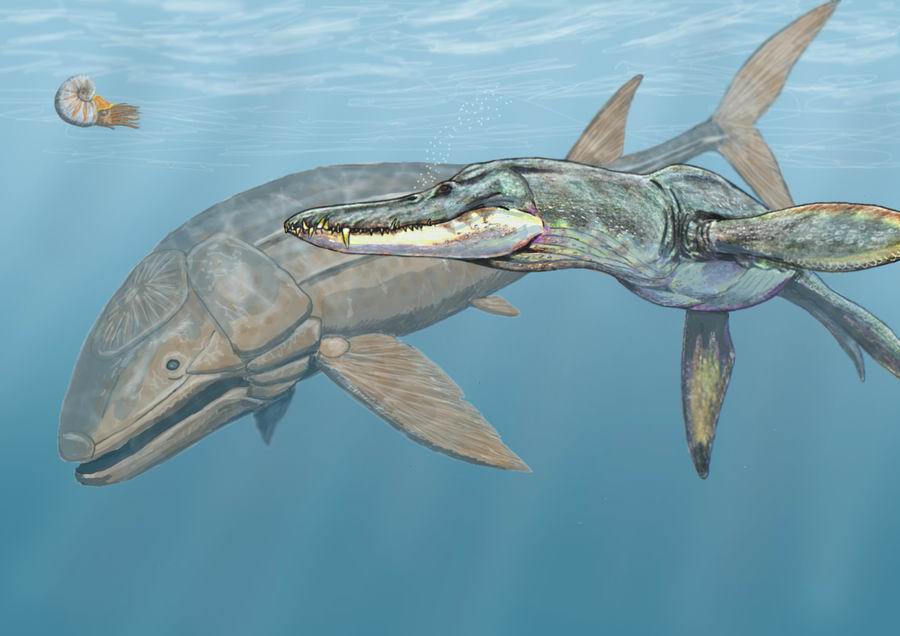- Leedsichthys
Taxobox
name = "Leedsichthys"
image_caption = "Leedsichthys problematicus" & "Liopleurodon ";Ammonite in background.
image_width = 250px
fossil_range =Middle Jurassic
regnum =Animal ia
phylum =Chordata
classis =Actinopterygii
ordo =Pachycormiformes
familia =Pachycormidae
genus = "Leedsichthys"
species = "L. problematicus"
binomial = "Leedsichthys problematicus""Leedsichthys problematicus" was a giant
pachycormid (an extinct group of Mesozoicbony fish ) that lived in the oceans of the MiddleJurassic period [(Liston, 2004)] . The closest living relative of the pachycormids is thebowfin "Amia calva", but this is only very distantly related. The name "Leedsichthys" means "Leeds' fish", after the fossil collector Alfred Nicholson Leeds, who discovered it before 1886 nearPeterborough, England [(Liston, 2004)] . The fossils found by Leeds gave the fish the species epithet "problematicus", because the remains were so fragmented that they were extremely hard to recognise and interpret [(Liston, 2004)] .The remains of "Leedsichthys" have been found in the Callovian of England, northern Germany and France, the Oxfordian of Chile, and the Kimmeridgian of France [(Liston, 2008a)] . Unfortunately, although the remains of over seventy individuals have been found, these are usual partial and fragmentary [(Liston, 2004)] . This has made it difficult to estimate its length. Arthur Smith Woodward, who described the specimen in 1889 [(Smith Woodward, 1889)] , estimated it to be 30 feet (around 9 metres) long [(Smith Woodward, 1905)] , by comparing the tail of "Leedsichthys" with another pachycormid, "Hypsocormus". In 1986, Martill compared the bones of "Leedsichthys" to a pachycormid that he had recently discovered [(Martill, 1986)] , but the unusual proportions of that specimen gave a wide range of possible sizes [(Liston, 2008b)] . More recent estimates, from documentation of historical finds [(Liston & Noè, 2004)] and the excavation of the most complete specimen ever from the Star Pit near Whittlesey, Peterborough [(Sloan, 2004] ; [Liston, 2006)] support Smith Woodward's figures of between 9 and 10 metres. Recent work on growth ring structures within the remains of "Leedsichthys" have also indicated that it would have taken 21-25 years to reach these lengths [(Liston, Steel & Challands, 2005)] , and isolated elements from other specimens indicate that a maximum size of just over 16 metres [(Liston, 2005)] is not unreasonable.
Like the largest fish today, the whale sharks and basking sharks, "Leedsichthys problematicus" derived its nutrition using an array of specialised gill rakers lining its gill basket to extract zooplankton from the water passing through its mouth and across its gills. There is little direct evidence for predation as opposed to scavenging on "Leedsichthys" remains, but specimen P.6924 in the Natural History Museum (London) shows signs of bites from a "Liopleurodon"-sized pliosaur. These bites have then healed, indicating that "Leedsichthys" could even escape the top predator of the Oxford Clay seas, probably as a result of its powerful tail.
References
*Liston, JJ (2004). An overview of the pachycormiform "Leedsichthys". In: Arratia G and Tintori A (eds) Mesozoic Fishes 3 - Systematics, Paleoenvironments and Biodiversity. Verlag Dr. Friedrich Pfeil, München, pp 379-390.
*Liston, JJ (2008a). "Leedsichthys" des Vaches Noires au peigne fin (translation by M-C Buchy) L’Écho des Falaises (=Ech.des Fal.) No.12: 41-49, 2008 ISSN 1253-6946.
*Smith Woodward, A (1889). Preliminary notes on some new and little-known British Jurassic fishes. Geological Magazine Decade 3 Volume 6: 448-455.
*Smith Woodward, A (1905). "A Guide to the Fossil Reptiles, Amphibians, and Fishes in the Department of Geology and Palaeontology of the British Museum (Natural History)". Eighth edition. British Museum (Natural History), London. Pp xviii, 110 pages.
*Martill, DM (1986). The world's largest fish. Geology Today March-April: 61-63.
*Liston, JJ (2008b). A review of the characters of the edentulous pachycormiforms "Leedsichthys", "Asthenocormus" and "Martillichthys" nov. gen. In: "Mesozoic Fishes 4 Homology and Phylogeny", G. Arratia, H.-P. Schultze & M. V. H. Wilson (eds.): pp. 181-198, 10 figs., 1 tab. © 2008 by Verlag Dr. Friedrich Pfeil, München, Germany – ISBN 978-3-89937-080-5.
*Liston, JJ & Noè, LF (2004). The tail of the Jurassic fish "Leedsichthys problematicus" (Osteichthyes: Actinopterygii) collected by Alfred Nicholson Leeds - an example of the importance of historical records in palaeontology. Archives of Natural History 31: 236-252.
*Sloan, C (2004). Big Fish Story. National Geographic Magazine, p.42. 1/9/2004.
*Liston, JJ (2006). From Glasgow to the Star Pit and Stuttgart: A short journey around the world's longest fish. The Glasgow Naturalist 24: 59-71.
*Liston, JJ, Steel, L & Challands, TJ (2005). Lured by the Rings: Growth structures in "Leedsichthys". In: Poyato-Ariza FJ (ed) Fourth International Meeting on Mesozoic Fishes - Systematics, Homology and Nomenclature, Extended Abstracts. Servicio de Publicaciones de la Universidad Autónoma de Madrid/UAM Ediciones, Madrid, pp 147-149.
*Liston, JJ (2005). Homologies amongst the fragments: searching for synapomorphies in shattered skulls. In: Poyato-Ariza FJ (ed) Fourth International Meeting on Mesozoic Fishes - Systematics, Homology and Nomenclature, Extended Abstracts. Servicio de Publicaciones de la Universidad Autónoma de Madrid/UAM Ediciones, Madrid, pp 141-145.
*Haines, Tim & Chambers, Paul. (2006). The Complete Guide to Prehistoric Life. Canada: Firefly Books Ltd.External links
* [http://www.big-dead-fish.com For more on the Star Pit dig of 2002-2003 look here] and also here where the dig was featured in [http://www.open2.net/fossildetectives/eastengland.html the BBC-Open University series Fossil Detectives.]
* [http://www.paleocreations.com For a more accurate reconstruction of "Leedsichthys" visit Paleocreations.] The artist went on to produce the most accurate reconstruction of "Leedsichthys" to date, which was used on 'Fossil Detectives' (see above).
* [http://www.bbc.co.uk/science/seamonsters/factfiles/leedsichthys.shtml The profile of "Leedsichthys problematicus" from the BBC series Sea Monsters]
* [http://news.nationalgeographic.com/news/2003/10/1001_031001_biggestfish.html "Biggest Fish Ever Found" Unearthed in U.K.] National Geographic News. Published October 1, 2003.
* [http://news.nationalgeographic.com/news/2003/10/1001_031001_biggestfish.html An article on the latest discovery of a "Leedsichthys problematicus" fossil] , estimated 22 meters = convert|72|ft|m long
* [http://www.bbc.co.uk/science/seamonsters/factfiles/images/leedsichthys1.jpgA picture of "Leedsichthys problematicus"]
Wikimedia Foundation. 2010.
